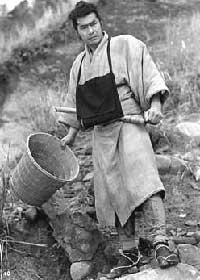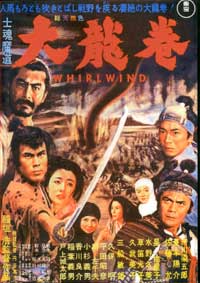Hiroshi Inagaki's Whirlwind aka The Way of the Warrior Soul (Shikonmado: Dai-tatsumaki, Toho, 1964) is a self-contained sequel to Daredevil in the Castle (Osaka jo monogatari, Toho, 1961).
 Whirlwind opens with a scene of the Summer Battle of Osaka Castle, where Yukimura Sanada died defending the castle frojm Ieyasu Tokugawa. This long sequence is beautifully staged & framed in widescreen full color conveying a real sense of massive destruction. After this big sequence the story settles down a whole lot & will wait until the climax to blow the rest of its budget on a special FX sequence. Whirlwind opens with a scene of the Summer Battle of Osaka Castle, where Yukimura Sanada died defending the castle frojm Ieyasu Tokugawa. This long sequence is beautifully staged & framed in widescreen full color conveying a real sense of massive destruction. After this big sequence the story settles down a whole lot & will wait until the climax to blow the rest of its budget on a special FX sequence.
A wonderful character array populates the story of the fates of individuals who survived that Summer Battle. Shuri Kusanagi is a rough samurai who stayed to the bitter end eager to fight no matter how uselessly for the chance to die valiantly in battle.
Jubei Fukami (Somegoro Ichikawa aka Shogoro Ichikawa) is a young swordsman of great bravery & skill who views this battle as his last chance in life to die a samurai's death. As opposing forces are tracking down & killing stragglers of the lost battle, Jubei finds an appealling vantage-point to view the landscape, where he intends to commit seppuku. His friend Kiyonosuke, who intends to live, tries to talk him out of it, but Jubei will not waver. Then Princess Kozato (Yuriko Hoshi) appears, having escaped from the castle with the child heir of the Toyotomis. She chastises Jubei that the battle is never lost for so long as the young Lord Kunimatsu Toyotomi lives.
Having still the duty to fight on, Jubei protects the young lord & Kozato from two ninjas, one of whom escapes because Jubei momentarily held back when he realized he was fighting a woman. She is the daughter of the ninja he just killed, so he has a new enemy who will pursue him for revenge.
Kozato's sister Kikusato just before the fall of the castle was attacked & raped by a Toyotomi warrior whose duty it was to protect her. "Don't hate me!" he said when he was done ravaging her. "Now I can have no regrets!" then commits seppuku before the castle is taken.
As Kikusato flees the castle she encounters Shuri Kusanagi with whom she had had a flirtation in better days, but he is wounded & seemingly beyond help. The enemy captures her & the ill-use of her body will continue.
Later the dart-throwing woman ninja captures Jubei along the road, but he is saved by a late-arriving new character to the tale, Toshiri Mifune as a wandering monk who wears a basket-like incognito-hat & fights with his shakuhachi flute (which, alas, he is never shown playing).
The fighting monk is actually Lord Kamon Akashi travelling in disguise for a long while because he is marked for death by Ieyasu. Kamon saves Jubei from capture, gives him a little lecture about the whirlwind soul of the samurai, then walks out of the first half of his cameo appearance not to reappear until near the end of the tale.
The story develops with relentless action & an aesthetic, serious, largely realistic approach. It nevertheless comes off as a "family" film & is very far from the severe sorts of samurai films called "cruel jidaigeki." Inagaki's Hiken (Young Swordsman, 1963) qualifies as cruel jidaigeki, but by & large his films are big entertainments & rarely harsh. So when the young Toyotomi lord is captured & is to be executed publicly, the audience doesn't worry too much for the kid, as we know Osaka survivors are already conspiring to save him.
The latter part of the story is nevertheless gloomy. Kikusato, the woman raped at the fall of Osaka Castle, has become a prostitute. When at last she is reunited with Shuri, she discovers he has become a crazed killer ronin who asks lone wayfarers, "Are you lucky or unlucky?" & no matter which they choose, he kills them. He goes with Kikusato back to her shack, where he kills her lazy pimps. The ruined couple -- whore & murderer -- begin an uneasy companionship, but neither gives up their currant ways.
 Meanwhile, the woman ninja proves unable to pursue a proper vengeance because as often happens in Inagaki films, she falls in love with her enemy. Meanwhile, the woman ninja proves unable to pursue a proper vengeance because as often happens in Inagaki films, she falls in love with her enemy.
When she next captures Jubei, it becomes a bit of a bondage & discipline sequence as she admits she would rather have his baby than get vengeance. She has an unwavering brother, however, so she releases Jubei asking only that he promise they will meet one more time (so she can get pregnant by him at least), a promise which he does not make.
Jubei & Kosaku are the lovers of the tale, but as their paths & fates keep crossing, it takes them an awfully long time to admit their feelings for one another. When it all looks bad for them, Mifune's character returns in the knick of time to insure that Kosaku & Jubei will live happily ever after.
More is going on than merits synopsis & several plot threads come together in what promises to be a big fight climax. But Inagaki pulls one of the biggest deux ex machina stunts of all time by having a special FX crew create quite a lovely gigantic tornado to toss people, trees, animals & houses round & round, cleansing the land of the filth of humanity.
The tornado selectively spares only the good guys. The final image of the film is Kamon, Jubei, & Kozato on a hill top looking off into the distance full of hope & promise. Though there is absolutely nothing wrong with Kozato's legs, Jubei carried her to that hilltop & keeps holding her as though she is crippled, just one more method Inagaki has for presenting wonderful female characters then undermining them as heroic primarily for their weakness.
 In all, it is not a great film, but it entertains. It has an intricate but not convoluted set of storylines very easy to follow. In all, it is not a great film, but it entertains. It has an intricate but not convoluted set of storylines very easy to follow.
Had Toshiro Mifune instead of Somogoro Ichikawa been the actual star of the piece it would've been a lot better as his small presence really fires up the story, despite that he is rather poorly integrated into the story & seems to be in it only as an afterthought (Inagaki would stick Mifune in everything if he could, even if only briefly, then let the film be advertised as though he starred in it).
The best part of the intersecting tales is the storyline regarding the killer ronin Shiru who never rises back out of his apparent depression & psychosis, & of the abused & ultimately doomed woman he can never admit he loves until it is too late.
To keep the film for the most part light, however, this one harsh storyline of madness & grief is comparatively subdued, & Ichikawa as the goody-two-shoes character of Jubei has most of the responsibility of carrying the film to success or failure.
copyright © by Paghat the Ratgirl
|

